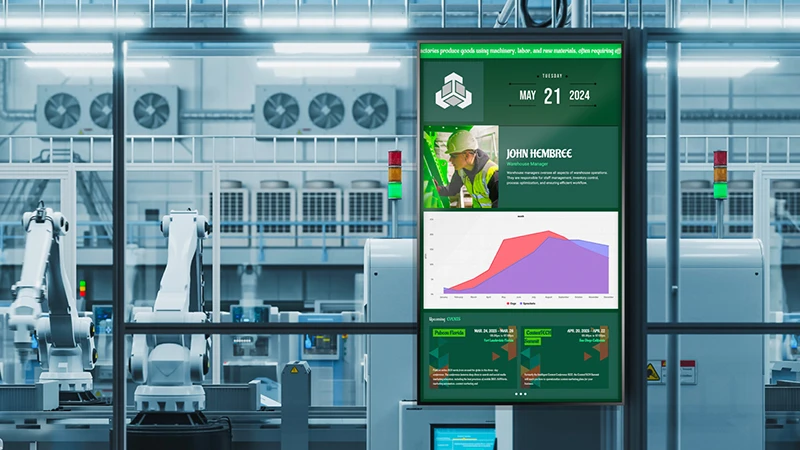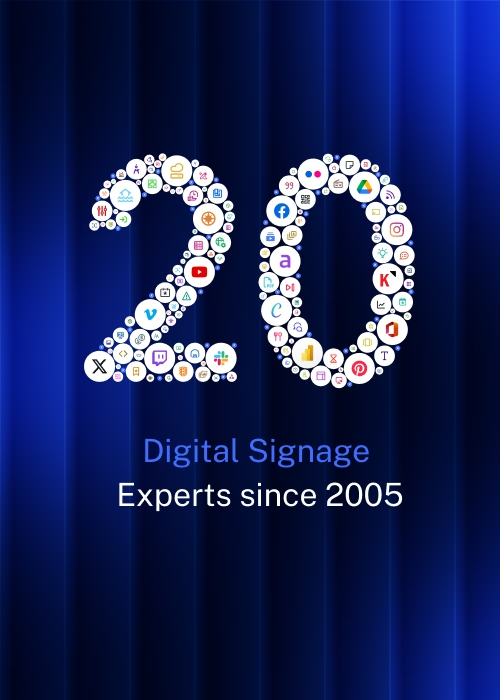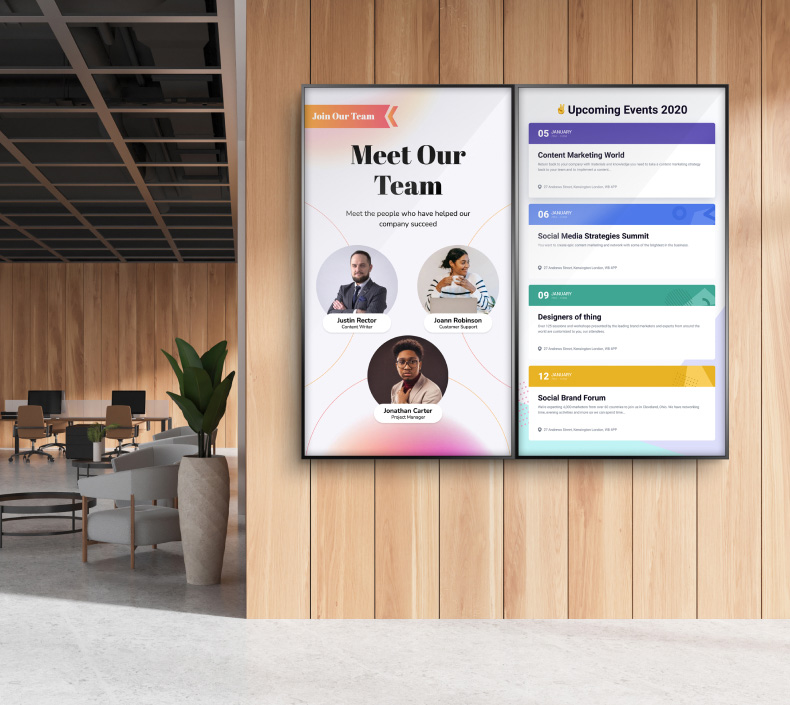Smarter Warehouses: The Power of Digital Signage
In fast-moving warehouse and transportation environments, communication is everything. Safety alerts, productivity updates, and scheduling information must reach employees instantly — across large, noisy spaces where traditional communication methods often fall short. This is where digital signage shines.

From boosting efficiency to keeping teams informed in real time, digital displays have become a key part of modern logistics operations. If you’re a warehouse manager or communications lead, digital signage can help you streamline processes, reduce downtime, and improve worker engagement.
Why Digital Signage Belongs in Modern Warehouses
Warehouses and distribution centers rely on coordination and speed. Yet communication breakdowns — missed messages, outdated schedules, or manual reporting — can easily derail operations.
Digital signage solves these problems by delivering dynamic, visual updates directly where employees are working. Instead of relying on email or bulletin boards, you can push important messages to every display in the facility instantly.
Key advantages include:
- Real-time communication: Instantly update shift schedules, production data, or delivery status.
- Enhanced safety: Use screens to display OSHA updates, PPE reminders, or emergency alerts.
- Employee engagement: Recognize achievements, share team goals, and reinforce company culture.
- Operational visibility: Show metrics like order accuracy, fulfillment speed, and downtime trends.
In large or noisy facilities, these visuals ensure critical information doesn’t get lost in the shuffle.
Practical Use Cases for Warehouse Digital Signage
Digital signage can serve dozens of functions in logistics and transport hubs. Below are some of the most common and impactful ones:
1. Real-Time Production & Logistics Dashboards
Displaying live metrics is one of the most powerful uses of digital signage in warehouses. Dashboards can pull data from ERP or WMS platforms to show:
- Orders processed per hour
- Current fulfillment rates vs. daily goals
- Truck or container status updates
- Inventory levels and restock alerts
Managers gain instant visibility into performance, while employees see tangible goals and progress. This helps create a culture of accountability and achievement across teams.

2. Shift & Task Management
Screens in break rooms or entrance areas can display up-to-date shift schedules, workstation assignments, or task rotations. This helps reduce confusion during shift changes — especially in facilities with rotating staff or multiple lines.
You can even integrate signage with scheduling software so changes automatically appear on screen without manual input.
3. Safety & Compliance Alerts
Keeping your workforce safe is critical. Digital signage can display rotating safety messages, equipment procedures, or emergency alerts in seconds.
For example:
- Flash “heat warning” notifications during summer months.
- Show proper lifting or equipment-use visuals.
- Push live evacuation or hazard alerts across all screens instantly.
These reminders help reduce accidents and demonstrate a proactive safety culture.
4. Employee Recognition & Motivation
Recognition builds morale — and morale drives performance. Use your displays to highlight standout employees, celebrate milestones, or showcase productivity wins.
A simple “Team A reached 105% of target today!” message reinforces positive behavior and strengthens team unity.
5. Logistics & Transportation Coordination
In transport hubs, digital displays can track shipment arrivals, load times, or dock assignments in real time. Drivers and floor teams can instantly see where to go next, minimizing delays and bottlenecks.
You can even set up zone-based messaging — so information at Dock 3 differs from what’s shown at the packing area or outbound gate.

Integrating Digital Signage Into Warehouse Operations
Installing displays is only the first step. To make signage work effectively, it needs to connect with your existing systems and workflows.
Centralized Content Management
A robust Content Management System (CMS) lets managers control all screens remotely — whether across one warehouse or several locations. You can schedule content, push emergency alerts, and monitor device health from a single dashboard.
Look for CMS software that includes:
- Automated data feeds (for metrics or schedules)
- Remote monitoring and updates
- Multi-user access with permission control
- Custom templates for safety, performance, or HR updates
This ensures consistency, reduces manual effort, and gives you flexibility to adapt messaging in real time.
Hardware & Installation Considerations
Warehouses are tough environments — with dust, vibrations, and temperature fluctuations. Choose industrial-grade displays built for continuous operation. For added protection, use sealed enclosures and anti-glare screens for visibility in bright lighting.
Typical costs per screen can include:
While this investment can seem significant, many facilities report a return on investment within the first year, especially from productivity gains and reduced communication delays.
How Communication Managers Benefit
For communication managers, digital signage isn’t just about displaying data — it’s about controlling the flow of information in a dynamic, measurable way.
It gives you tools to:
- Segment content for different departments or areas.
- Measure message engagement and screen uptime.
- Update content across facilities in seconds.
You can also integrate company-wide communications — like HR updates, training reminders, or corporate announcements — into the same system. This ensures alignment between operations and headquarters, even in distributed organizations.
Measuring Impact: The ROI of Warehouse Digital Signage
The true power of digital signage is in its ability to turn data and communication into results. Facilities that adopt digital signage often see:
- Faster information delivery: Messages reach workers immediately, reducing downtime.
- Improved safety metrics: Regular reminders and alerts lower incident rates.
- Higher employee engagement: Recognition and visibility keep morale strong.
- Optimized workflows: Real-time metrics help teams hit targets consistently.
To track success, monitor KPIs such as:
- Average time to communicate new procedures
- Rate of safety incidents before and after deployment
- Throughput or order accuracy improvements
- Employee feedback and satisfaction scores
Real-World Example: A Regional Distribution Center
One regional warehouse integrated digital signage with its WMS to track hourly throughput and order accuracy. Within three months, supervisors noted a 12% productivity increase and a 22% drop in errors.
Employees said the screens helped them “see progress in real time” and better understand how their work contributed to daily goals. This transparency built a stronger team culture — one based on visibility, not guesswork.
Getting Started: Best Practices for Implementation
If you’re considering adding digital signage to your warehouse or transport facility, start with a clear rollout plan:
- Identify key communication challenges. Are safety updates slow? Is shift handoff chaotic?
- Map display locations. Focus on high-traffic areas — break rooms, loading docks, entrances.
- Define your content strategy. Plan for a mix of operational metrics, safety messages, and morale content.
- Choose scalable hardware and CMS software. Future-proof your setup so you can expand easily.
- Train your team. Ensure supervisors and managers know how to update and schedule content.
Once live, monitor performance and adjust messaging regularly to keep displays relevant and impactful.
The Future of Warehouse Communication
As automation and data integration continue to reshape logistics, digital signage will play a growing role in bridging human teams with digital systems.
Imagine dashboards that automatically adjust content based on production speed, or safety screens that change visuals when forklifts enter certain zones. AI and IoT integrations are already making these scenarios possible.
For warehouse and communication managers, adopting digital signage isn’t just about modernizing operations — it’s about building a smarter, safer, and more connected workplace.
Final Thoughts
Digital signage transforms warehouse communication from reactive to proactive. It brings real-time visibility to the floor, keeps teams informed and motivated, and strengthens operational efficiency from end to end.
Whether your facility handles freight, distribution, or production, the message is clear: better communication leads to better performance — and digital signage is one of the most effective ways to achieve it.






